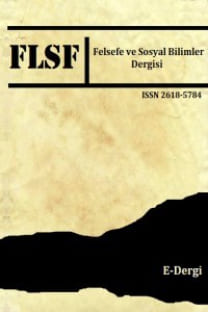HUKUKUN (Sİ)YASAL KAYNAĞI OLARAK EGEMENLİĞİN İKİ YÜZÜ
Bu incelemede, hukukun temelinde yatan ve hukuka (si)yasal müdahale olanağının kapısını açan birbiriyle ilişkili ama temel olarak farklı biçimlerde gelişen egemenliğin iki yüzü analiz edilmektedir. Egemenliğin (si)yasal olarak hukuka müdahalesinin olanağını oluşturan birinci yüzü, iktidarın gücü -şiddet araçları tekelini- elinde bulunduran dinamiğinden ileri gelir. Egemen gücün “yasa kuran” ve “yasa koruyan” bir olguyla hukuka kaynaklık eden yapısı, onu hukuka “üstün” kılabilecek “doğal” bir konuma yerleştirir. Egemenliğin hukuk karşısında ikinci yüzünü oluşturan (si)yasal ilişki, istisna hali kuramında dile gelen durumdan kaynaklanır. Egemen erkin olağan hallerin dışında olağanüstü durumlarda istisna hali ilan ederek hukuku askıya almasını ifade eden bu durum, “zorunluluktan” ileri gelmektedir. Egemenliğin hukuk ile ilişkisindeki birinci yüzde ortaya çıkan (si)yasal ilişki doğallığa karşılık düşerken, ikinci yüzde zorunluluk hâkimdir. Her iki durumda da, egemenlik kategorisi üzerinden gelişen sürecin kaynağında, siyasal olan ile yasal olan arasındaki çatışmanın kendisi yatmaktadır. Bu çatışma döngüsünde yatan temel sorun, egemenliğin iki yüzündeki (doğallık ile zorunluluk) zeminin kaynağını oluşturan “meşru” sınırın -hukuka rağmen onu işlevsiz bırakan tutumun- kaynağını nereden ve nasıl alabildiğidir?
Anahtar Kelimeler:
Egemenlik, Hukuk, Siyaset, Yasa, Doğallılık, Zorunluluk
Two Faces of Sovereignity as the Political Source of Law
In this article, two faces of sovereignity that make the possibility of politic(leg)al intervention in law available, and are related to each other, and are essentially developing in different ways are analyzed. The first face that composes the possibility of politic(leg)al intervention of sovereignity in law rises up from the dynamics of government which controls power, namely manopoly of means of violence. Sovereign power’s structure, being the source of law with its properties such as “forming rule” and “protecting rule” put it in a “natural” position of being “superior” to law. The politic(leg)al relation that compose the second face of sovereignity in relation to law is brought out by the situation articulated in the theory of exceptional situation. This situation expresses govermental cancellation of law by declaring the situation as exceptional in the state of emergency and this is expected to be understood as the result of “necessity”. Whereas the politic(leg)al relation appeared on the first face of the relation between sovereignity and law corresponds to naturality, on the second face it corresponds to necessity. On both situation lies the conflict itself that is between the political and the legal. The main problem underlying this circle of conflict is from where and how the border of legality that compose the source for both faces of sovereignity, namely naturality and necessity, gets its source
Keywords:
Sovereignity, Law, Politics, Rule, Naturality, Necessity.,
___
- AGAMBEN, Giorgio. Homo Sacer -Sovereign Power and Bare Life-, (Translated by Daniel Heler-Roazen), Stanford California: Stanford University Press, 1998.
- AGAMBEN, Giorgio. Potentialities -Collected Essays in Philosophy- (Edited and Translated by Daniel Heler Roazen), California: Stanford University Press, 1999.
- AGAMBEN, Giorgio. State of Exception, (Translated by Kevin Attel), Chicago and London: The University of Chicago Press, 2005.
- BENJAMIN, Walter. Reflections -Essays, Aphorisms, Autobiographical Writings- Crituque of Violence, (Edited and with an İntroduction by Peter Demetz, Translated by Edmund Jephcott), New York: Schocken Books, 1986.
- BUTLER, Judith. Kırılgan Hayat -Yasın ve Şiddetin Gücü- (Çev. Başak Ertür), İstanbul: Metis Yayınları, 2004.
- DERRIDA, Jacques. Deconstruction and the Possibility of Justice içinde -Force of Law: Mystical Foundation of Authority- (Edited by D rucilla Cornell, Michel Rosenfeld, David Gray Carlson), USA: Published by Routledge, Chapman and Hall, Inc., 1992.
- SCHMİTT, Carl. “Siyasi İlahiyat -Egemenlik Kuramı Üzerine Dört Deneme-”, Çev. Emre Zeybekoğlu, Dost Kitabevi Yayınları, 2002, Ankara.
- Yayın Aralığı: Yılda 2 Sayı
- Başlangıç: 2006
- Yayıncı: Hamdi BRAVO
Sayıdaki Diğer Makaleler
PRAGMATİZM, DİL, BETİMLEYEBİLİRLİK VE ETİK
DİNLE UYUMLU KOLLEKTİF BİR DEĞER OLARAK DOĞU HİKMETİ
SOKRATES’İN YURTSEVERLİĞİ: SÖZ VERMEK, SÖZÜNDE DURMAK VE İNSANA SAYGI
İMKÂNLAR ALANI OLARAK DİN: DEWEY’İN DİN FELSEFESİ
PARMENİDES FELSEFESİNİN VARLIĞI TEMELLENDİRME TARZININ KENDİNDEN SONRAKİ FELSEFEYE ETKİLERİ
DEĞER VE ANLAM: DEĞERLER ANLAMLAR MIDIR?
PLATON VE ARİSTOTELES’İN BİLİMLERE İLİŞKİN SINIFLAMALARI
E. HUSSERL’DE NOEMA VE NOESİS KAVRAMLARI
KARL POPPER’IN TARİH, TOPLUM VE SİYASET FELSEFESİ ÜZERİNE GÖRÜŞLERİ
